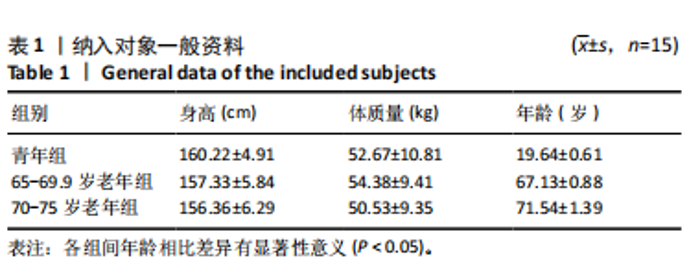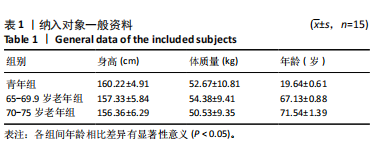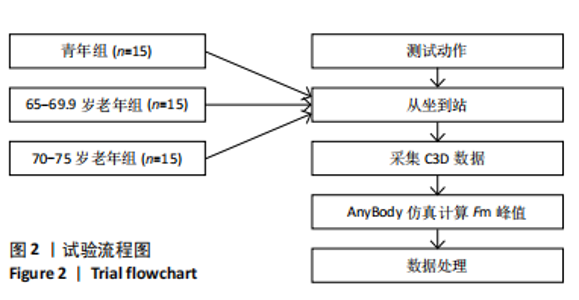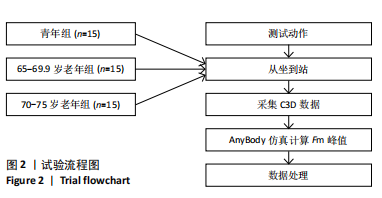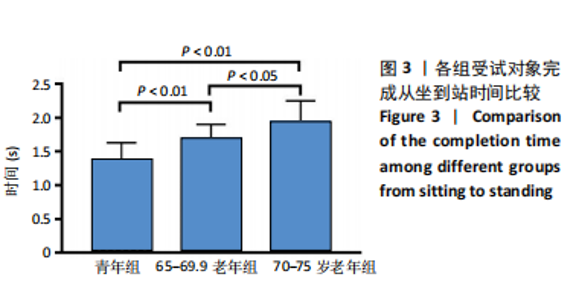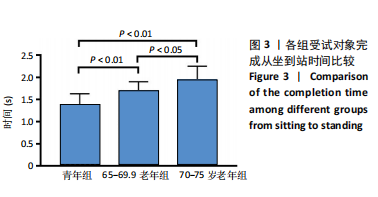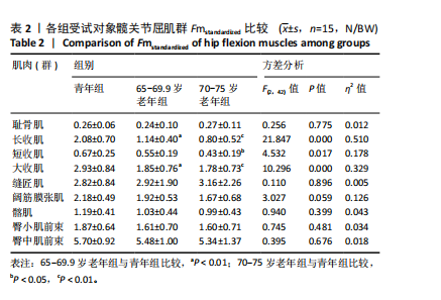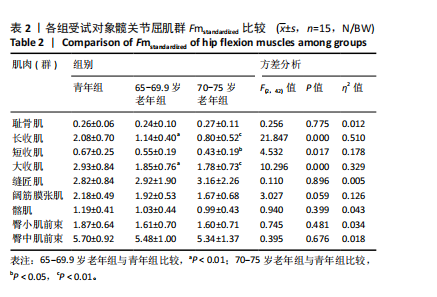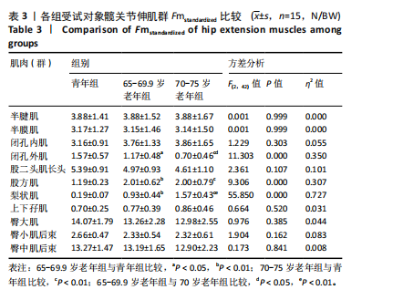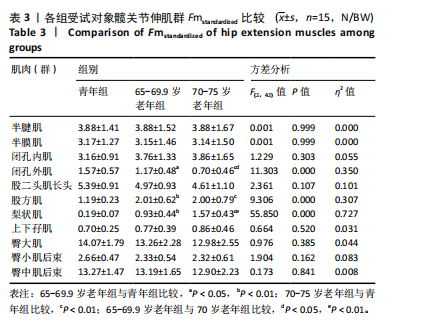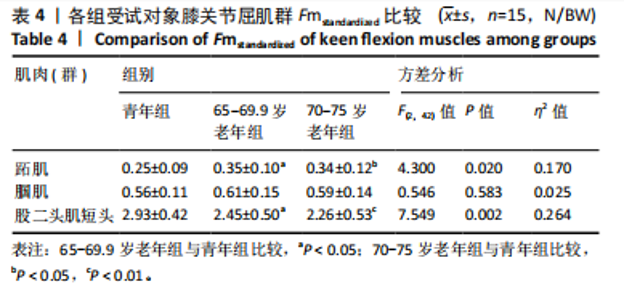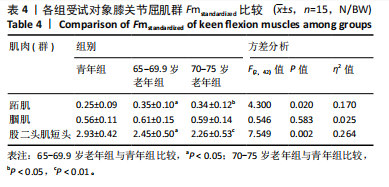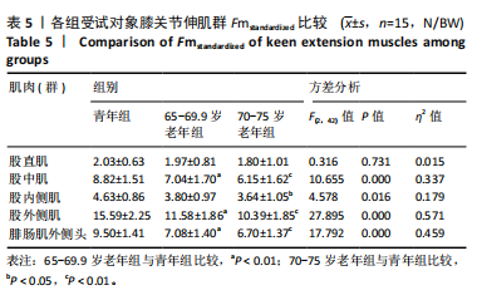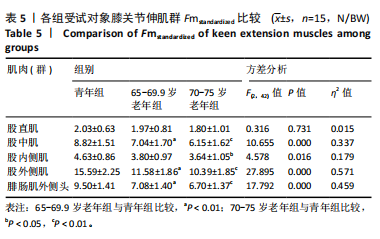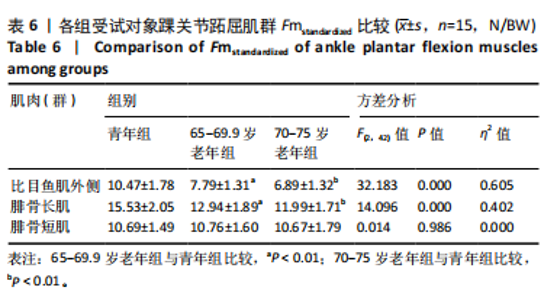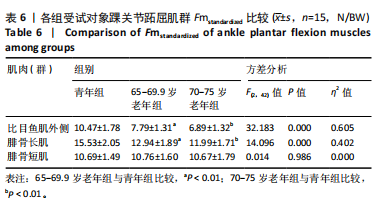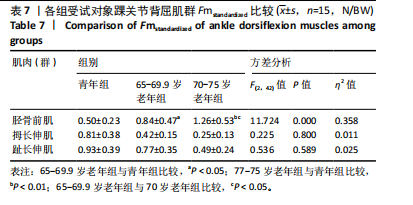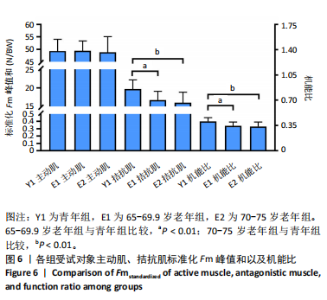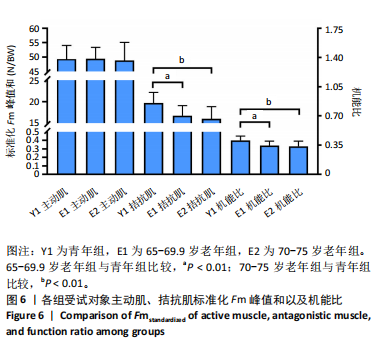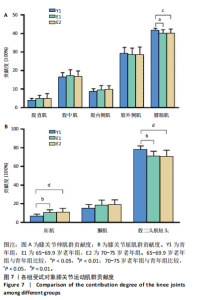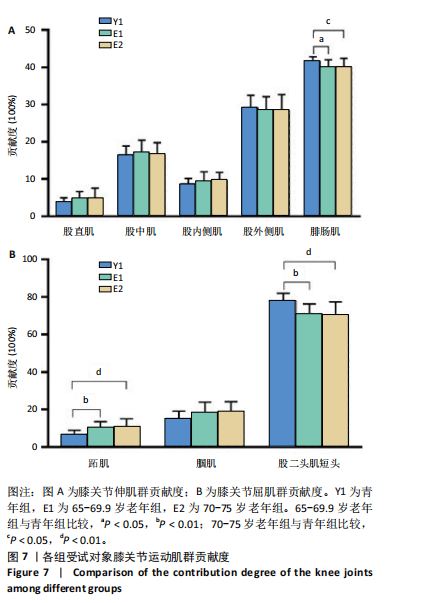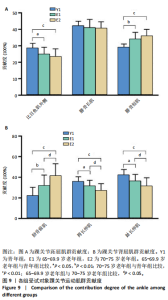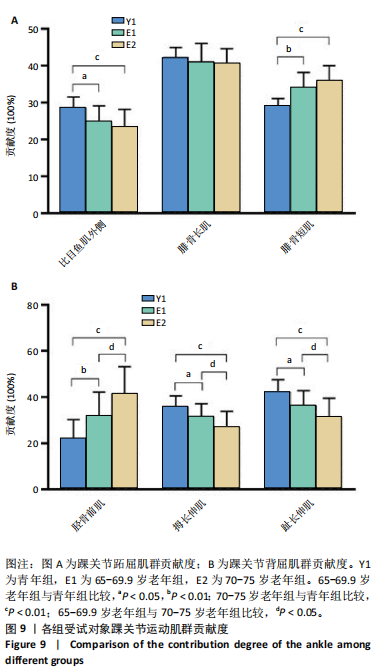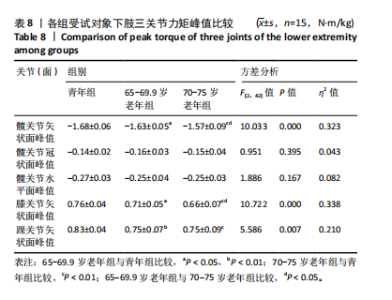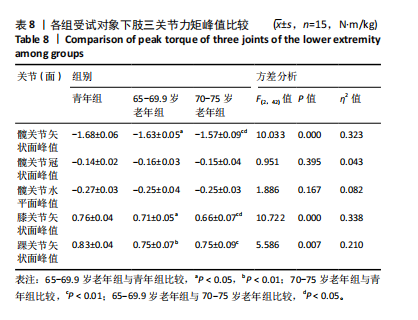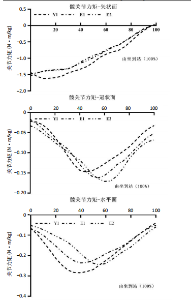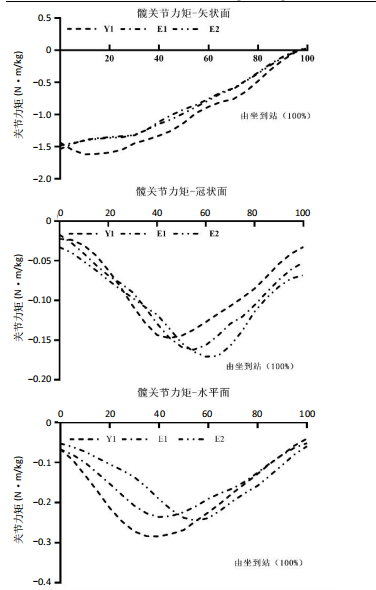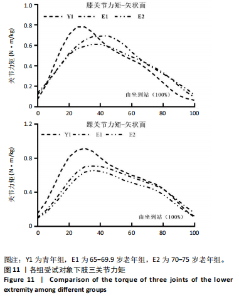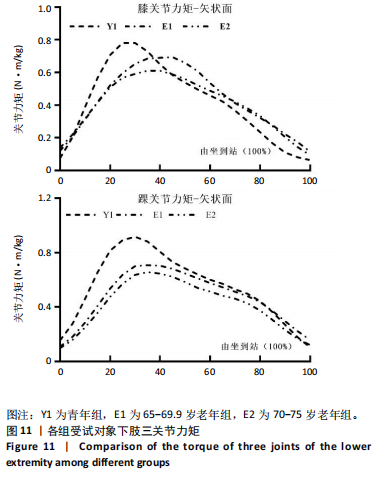Chinese Journal of Tissue Engineering Research ›› 2026, Vol. 30 ›› Issue (6): 1407-1416.doi: 10.12307/2026.506
Previous Articles Next Articles
Simulation and force characterization of the lower limbs in elderly people from sitting to standing
Zhang Zihua1,2, 3
- 1School of Sports and Health Science, Tongren University, Tongren 554300, Guizhou Province, China; 2Postdoctoral Mobile Station of Sports Science, Chengdu Sport University, Chengdu 610041, Sichuan Province, China; 3School of Physical Education, Guizhou University, Guiyang 550025, Guizhou Province, China
-
Received:2024-11-15Accepted:2025-01-14Online:2026-02-28Published:2025-07-15 -
Contact:Zhang Zihua, School of Sports and Health Science, Tongren University, Tongren 554300, Guizhou Province, China; Postdoctoral Mobile Station of Sports Science, Chengdu Sport University, Chengdu 610041, Sichuan Province, China; School of Physical Education, Guizhou University, Guiyang 550025, Guizhou Province, China -
About author:Zhang Zihua, PhD, Professor, Master’s supervisor, School of Sports and Health Science, Tongren University, Tongren 554300, Guizhou Province, China; Postdoctoral Mobile Station of Sports Science, Chengdu Sport University, Chengdu 610041, Sichuan Province, China; School of Physical Education, Guizhou University, Guiyang 550025, Guizhou Province, China -
Supported by:General Project of Education Science Planning of Guizhou Province, No. 2023B046 (to ZZH); Basic Research Plan Project of Tongren Science and Technology Bureau, No. [2023]50 (to ZZH); Doctoral Research Initiation Fund Project of Tongren University, No. trxyDH2114 (to ZZH); Guizhou Province High-level Innovative Talent Training Project, No. 2024-(2023)-071 (to ZZH)
CLC Number:
Cite this article
Zhang Zihua. Simulation and force characterization of the lower limbs in elderly people from sitting to standing[J]. Chinese Journal of Tissue Engineering Research, 2026, 30(6): 1407-1416.
share this article
Add to citation manager EndNote|Reference Manager|ProCite|BibTeX|RefWorks
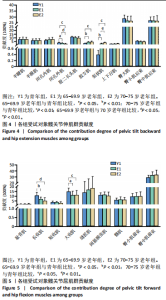
2.6 下肢肌群贡献度和机能比 2.6.1 髋关节运动肌群贡献度和机能比 各组受试者闭孔外肌[F(2,42)=9.583,P=0.000,η2=0.313]、股方肌[F(2,42)=10.339,P=0.000,η2=0.330]、梨状肌[F(2,42)=52.575,P=0.000,η2=0.715]、长收肌[F(2,42)=13.034,P=0.000,η2=0.383]、大收肌贡献度[F(2,42)=3.754,P=0.032,η2=0.152]差异显著,拮抗肌力量[F(2,42)=8.837,P=0.001,η2=0.296]、机能比[F(2,42)=8.159,P=0.001,η2=0.280]差异显著。各组受试者半腱肌[F(2,42)=0.003,P=0.997,η2=0.000]、半膜肌 [F(2,42)=0.003,P=0.997,η2=0.000]、闭孔内肌[F(2,42)= 1.425,P=0.252,η2=0.064]、股二头肌长头[F(2,42)= 2.202,P=0.123,η2=0.095]、上下孖肌[F(2,42)=0.635,P=0.535,η2=0.029]、臀大肌[F(2,42)=1.310,P=0.281,η2=0.059]、臀小肌后[F(2,42)=2.451,P=0.098,η2=0.105]、臀中肌后[F(2,42)=0.056,P=0.946,η2=0.003]、耻骨肌[F(2,42)=1.543,P=0.226,η2=0.068]、短收肌[F(2,42)= 1.113,P=0.338,η2=0.050]、缝匠肌[F(2,42)=0.881,P= 0.422,η2=0.040]、阔筋膜张肌[F(2,42)=0.457,P=0.636,η2=0.021]、髂肌[F(2,42)=0.049,P=0.952,η2=0.002]、臀小肌前束[F(2,42)=0.059,P=0.943,η2=0.003]、臀中肌前束[F(2,42)=2.616,P=0.085,η2=0.111]的贡献度差异不显著,主动肌力量[F(2,42)=0.056,P=0.946,η2=0.003]差异不显著。各肌群统计值及组间差异如图4-6所示。 2.6.2 膝关节运动肌群贡献度和机能比 各组腓肠肌外侧[F(2,42)=3.667,P=0.034,η2=0.149]、跖肌[F(2,42)=7.071,P=0.002,η2=0.252]和股二头肌短头[F(2,42)=8.891,P=0.001,η2=0.300]贡献度差异显著,主动肌力量[F(2,42)=63.604,P=0.000,η2=0.752]、拮抗肌力量[F(2,42)=5.101,P=0.009,η2=0.195]、机能比[F(2,42)=12.592,P=0.000,η2=0.375]差异显著。各组股直肌[F(2,42)=1.461,P=0.244,η2=0.065]、股中肌(F(2,42)="
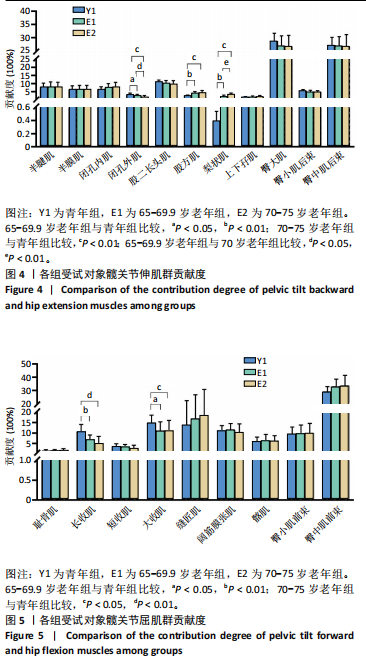
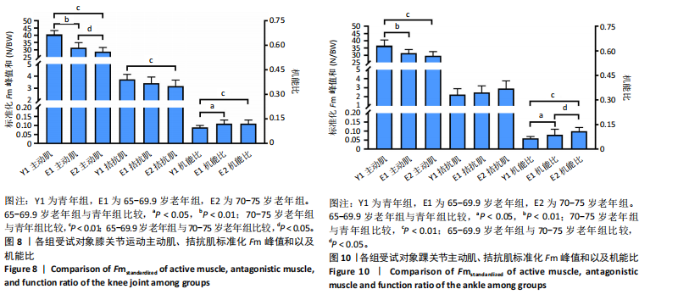
2.6.3 踝关节运动肌群贡献度和机能比 各组比目鱼肌外侧[F(2,42)=6.762,P=0.003,η2=0.244]、腓骨短肌[F(2,42)=16.198,P=0.000,η2=0.435]、胫骨前肌[F(2,42)=14.116,P=0.000,η2=0.402]、拇长伸肌[F(2,42)=8.997,P=0.001,η2=0.300]、趾长伸肌[F(2,42)=9.524,P=0.000,η2=0.312)贡献度差异显著,主动肌力量[F(2,42)=20.656,P=0.000,η2=0.496]和机能比[F(2,42)=12.733,P=0.000,η2=0.377]差异显著。各组腓骨长肌[F(2,42)=0.739,P=0.484,η2=0.034]贡献度差异不显著,拮抗肌力量[F(2,42)=2.959,P=0.063,η2=0.377]差异不显著性。各肌群统计值及组间差异如图9,10所示。"
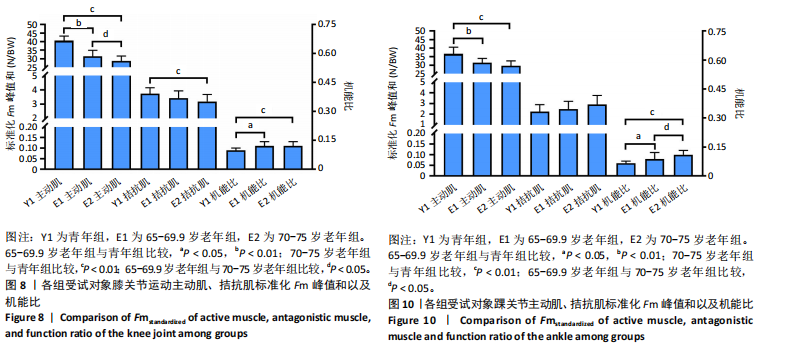
| [1] YANG C, MO Y, CAO X, et al. Reliability and validity of the Tinetti performance oriented mobility assessment in Chinese community-dwelling older adults. Geriatr Nurs. 2023;53:85-89. [2] MUTCHIE HL, ORWIG DL, BEAMER B, et al. Four Square Step Test Performance in Hip Fracture Patients. J Geriatr Phys Ther. 2022;45(2): 81-89. [3] LAURETANI F, TICINESI A, GIONTI L, et al. Short-Physical Performance Battery (SPPB) score is associated with falls in older outpatients. Aging Clin Exp Res. 2019;31(10):1435-1442. [4] FIEDOROVÁ I, MRÁZKOVÁ E, ZÁDRAPOVÁ M, et al. Receiver Operating Characteristic Curve Analysis of the Somatosensory Organization Test, Berg Balance Scale, and Fall Efficacy Scale-International for Predicting Falls in Discharged Stroke Patients. Int J Environ Res Public Health. 2022;19(15):9181. [5] MAGNANI PE, GENOVEZ MB, PORTO JM, et al. Use of the BESTest and the Mini-BESTest for Fall Risk Prediction in Community-Dwelling Older Adults Between 60 and 102 Years of Age. J Geriatr Phys Ther. 2020;43(4):179-184. [6] REOLI R, THERRIEN A, CHERRY-ALLEN K, et al. Is the dynamic gait index a useful outcome to measure balance and ambulation in patients with cerebellar ataxia? Gait Posture. 2021;89:200-205. [7] BARRY E, GALVIN R, KEOGH C, et al. Is the Timed Up and Go test a useful predictor of risk of falls in community dwelling older adults: a systematic review and meta-analysis. BMC Geriatr. 2014;14:14. [8] FALLAHTAFTI F, BORON JB, VENEMA DM, et al. Task specificity impacts dual-task interference in older adults. Aging Clin Exp Res. 2021;33(3):581-587. [9] ZASADZKA E, BOROWICZ AM, ROSZAK M, et al. Assessment of the risk of falling with the use of timed up and go test in the elderly with lower extremity osteoarthritis. Clin Interv Aging. 2015;10:1289-1298. [10] JEONG SM, SHIN DW, HAN K, et al. Timed up-and-go test is a useful predictor of fracture incidence. Bone. 2019;127:474-481. [11] KELLIS E, SAHINIS C, BALTZOPOULOS V. Is hamstrings-to-quadriceps torque ratio useful for predicting anterior cruciate ligament and hamstring injuries? A systematic and critical review. J Sport Health Sci. 2023;12(3):343-358. [12] BENAVENT-CABALLER V, SENDÍN-MAGDALENA A, LISÓN JF, et al. Physical factors underlying the Timed “Up and Go” test in older adults. Geriatr Nurs. 2016;37(2):122-127. [13] ABD ELKADER SM, AL-SHENQITI AM, EL-GOHARY TM. Timed Up and Go and Five Times Sit to Stand Test among community ambulant, overweight, obese Saudi elderly population. J Pak Med Assoc. 2022; 72(7):1306-1310. [14] KUROSAWA C, SHIMAZU N, YAMAMOTO S. Where do healthy older adults take more time during the Timed Up and Go test? J Phys Ther Sci. 2020;32(10):663-668. [15] GUTTENBERG M, ARGENTO G, MCINERNEY D, et al. Does the Timed-Up-and-Go Test Predict Length of Stay After Total Hip Arthroplasty? A Retrospective Study. HSS J. 2024;20(2):182-186. [16] BEAUCHET O, FANTINO B, ALLALI G, et al. Timed Up and Go test and risk of falls in older adults: a systematic review. J Nutr Health Aging. 2011;15(10):933-938. [17] ORTEGA-BASTIDAS P, GÓMEZ B, AQUEVEQUE P, et al. Instrumented Timed Up and Go Test (iTUG)-More Than Assessing Time to Predict Falls: A Systematic Review. Sensors (Basel). 2023;23(7):3426. [18] MARTINO G, BECK ON, TING LH. Voluntary muscle coactivation in quiet standing elicits reciprocal rather than coactive agonist-antagonist control of reactive balance. J Neurophysiol. 2023;129(6):1378-1388. [19] FRITZSCHE L, GALIBAROV PE, GÄRTNER C, et al. Assessing the efficiency of exoskeletons in physical strain reduction by biomechanical simulation with AnyBody Modeling System. Wearable Technol. 2021;2:e6. [20] KONG YK, CHOI KH, CHO MU, et al. Ergonomic Assessment of a Lower-Limb Exoskeleton through Electromyography and Anybody Modeling System. Int J Environ Res Public Health. 2022;19(13):8088. [21] PEREIRA CB, KANASHIRO AMK. Falls in older adults: a practical approach. Arq Neuropsiquiatr. 2022;80(5 Suppl 1):313-323. [22] CHANDER DS, CAVATORTA MP. Multi-directional one-handed strength assessments using AnyBody Modeling Systems. Appl Ergon. 2018;67:225-236. [23] FELDMAN AG. The Relationship Between Postural and Movement Stability. Adv Exp Med Biol. 2016;957:105-120. [24] JOHN CT, SETH A, SCHWARTZ MH, et al. Contributions of muscles to mediolateral ground reaction force over a range of walking speeds. J Biomech. 2012;45(14):2438-2443. [25] MOOKERJEE S, MCMAHON MJ. Electromyographic analysis of muscle activation during sit-and-reach flexibility tests. J Strength Cond Res. 2014;28(12):3496-3501. [26] MARTINEZ SC, COONS JM, MEHLS KD. Effect of external load on muscle activation during the barbell back squat. Eur J Sport Sci. 2023; 23(6):975-982. [27] ZHANG Q, HAUTIER CA. Influence of jump-landing direction on dynamic postural stability and hamstring-to-quadriceps co-activation ratio. Res Sports Med. 2023;31(4):331-341. [28] FLIX-DÍEZ L, BLANCO-PAREJA M, PÉREZ-FERNÁNDEZ N. Limits of Stability during a Therapeutic Exercise Intervention for Instability: Progression, Responders’ and Non-Responders’ Analysis and Predictors. J Clin Med. 2024;13(17):5036. [29] KOJIMA G, MASUD T, KENDRICK D, et al. Does the timed up and go test predict future falls among British community-dwelling older people? Prospective cohort study nested within a randomised controlled trial. BMC Geriatr. 2015;15:38. [30] ROCKWOOD K, AWALT E, CARVER D, et al. Feasibility and measurement properties of the functional reach and the timed up and go tests in the Canadian study of health and aging. J Gerontol A Biol Sci Med Sci. 2000;55(2):M70-73. [31] KARIMI MT, SHARIFMORADI K. Static and local dynamic stability of subjects with knee joint osteoarthritis. Proc Inst Mech Eng H. 2022; 236(8):1100-1105. [32] BRANDT C, VAN VUUREN ECJ. Postoperative Physiotherapy in Women Undergoing Pelvic Floor Reconstructive Surgery: A Randomized Controlled Clinical Trial. Physiother Can. 2021;74(2):126-138. [33] PASCUCCI F, CESARI P, BERTUCCO M, et al. Postural adjustments to self-triggered perturbations under conditions of changes in body orientation. Exp Brain Res. 2023;241(8):2163-2177. [34] JEON W, WHITALL J, GRIFFIN L, et al. Trunk kinematics and muscle activation patterns during stand-to-sit movement and the relationship with postural stability in aging. Gait Posture. 2021;86:292-298. [35] SADEH S, GOBERT D, SHEN KH, et al. Biomechanical and neuromuscular control characteristics of sit-to-stand transfer in young and older adults: A systematic review with implications for balance regulation mechanisms. Clin Biomech (Bristol). 2023;109:106068. [36] ROELKER SA, SCHMITT LC, CHAUDHARI AMW, et al. Discover your potential: The influence of kinematics on a muscle’s ability to contribute to the sit-to-stand transfer. PLoS One. 2022;17(3):e0264080. [37] YOSHIOKA S, NAGANO A, HIMENO R, et al. Computation of the kinematics and the minimum peak joint moments of sit-to-stand movements. Biomed Eng Online. 2007;6:26. [38] VAN HOOREN B, ZOLOTARJOVA J. The Difference Between Countermovement and Squat Jump Performances: A Review of Underlying Mechanisms With Practical Applications. J Strength Cond Res. 2017;31(7):2011-2020. [39] KAEWMANEE T, ARUIN AS. The Role of Predictability of Perturbation in Control of Posture: A Scoping Review. Motor Control. 2022;26(1): 97-143. [40] VAN DEN BOGAART M, BRUIJN SM, VAN DIEËN JH, et al. The effect of anteroposterior perturbations on the control of the center of mass during treadmill walking. J Biomech. 2020;103:109660. |
| [1] | Ao Xiaojing, Li Kun, Liu Yuhang, Yang Xiaoxuan, Wang Xing, Li Zhijun, Ren Xiaoyan, Zhang Shaojie. Development and application of a three-dimensional digital visualization system for children’s neck acupoints [J]. Chinese Journal of Tissue Engineering Research, 2025, 29(9): 1834-1840. |
| [2] | Chen Yueping, Chen Feng, Peng Qinglin, Chen Huiyi, Dong Panfeng . Based on UHPLC-QE-MS, network pharmacology, and molecular dynamics simulation to explore the mechanism of Panax notoginseng in treating osteoarthritis [J]. Chinese Journal of Tissue Engineering Research, 2025, 29(8): 1751-1760. |
| [3] | Li Chen, Liu Ye, Ni Xindi, Zhang Yuang. Simulation analysis of real-time continuous stiffness in muscle fibers and tendons of the triceps surae during multi-joint movement [J]. Chinese Journal of Tissue Engineering Research, 2025, 29(35): 7529-7536. |
| [4] | Sun Yuan, Yang Chen, Ma Yunchao. Computer simulation analysis of medial tibial stress during running [J]. Chinese Journal of Tissue Engineering Research, 2025, 29(27): 5802-5809. |
| [5] | Liu Yuhang, Li Hongyu, Wang Yong, Wang Fengxing. Visual analysis of application of three-dimensional finite element method in femoral head necrosis [J]. Chinese Journal of Tissue Engineering Research, 2025, 29(27): 5933-5940. |
| [6] | Lin Yixin, Wang Wenyi, Lei Xiaoqing, Ma Dezun, Huang Yanfeng, Fu Changlong, Ye Jinxia. Tougu Xiaotong Capsules for treating arthritis according to the principle of “Same Treatment for Different diseases”: analysis based on integrated pharmacology, molecular docking techniques and molecular dynamics simulation [J]. Chinese Journal of Tissue Engineering Research, 2025, 29(24): 5093-5101. |
| [7] | Wang Yuning, Zhu Haotian, Liu Kang, Ding Huanwen, Yan Han. Comparison of short-term therapeutic effects between digital precision total knee arthroplasty and traditional methods [J]. Chinese Journal of Tissue Engineering Research, 2025, 29(21): 4521-4528. |
| [8] | Zhao Yuhan, Li Yamei, Yan Shifang, Jiang Huabei. Immediate effects of different stretching methods on knee joint muscle strength and vertical jump performance of healthy adults [J]. Chinese Journal of Tissue Engineering Research, 2025, 29(18): 3784-3790. |
| [9] | Bai Xue, Wang Xing, Hong Guoping, Jia Rushuo, Han Qi, Guo Huaiyu, Niu Hongkai, Zhang Shaojie, Chao Lumen. A three-dimensional virtual simulation platform for Mongolian medical brain vibration therapy constructed based on the three-dimensional motion capture technology [J]. Chinese Journal of Tissue Engineering Research, 2025, 29(18): 3826-3832. |
| [10] | Tang Fubo, Zhong Yuanming, Li Zhifei. Finite element mechanical analysis of different screw-rod internal fixation methods in lateral lumbar fusion [J]. Chinese Journal of Tissue Engineering Research, 2024, 28(21): 3293-3298. |
| [11] | Cao Xuekun, Dong Wanpeng, Dong Yuefu, Zhang Zhen, Zhang Jichao, Li Jiayi, Su Dejun, Ma Honghao. Structural design of tibial intramedullary stem of artificial knee joint [J]. Chinese Journal of Tissue Engineering Research, 2024, 28(21): 3326-3333. |
| [12] | Liu Yuhang, Sun Ruifen, Mu Rigen Jiya, Wang Xing, Li Zhijun, Liu Yanan, Hao Yunteng, Cai Yongqiang, Zhang Shaojie, Li Kun. Development of a three-dimensional digital children’s acupuncture point visualization system of Mongolian medicine [J]. Chinese Journal of Tissue Engineering Research, 2024, 28(20): 3223-3228. |
| [13] | Tang Ziyan, Gu Shunqiang, Chen Xiaoling, Wang Lei, Ma Chengbang, Zhou Mei, Chen Tianbao, Du Lina, Jin Yiguang. Recombinant expression and in vitro activity identification of a bioactive peptide QUB2984 from skin secretion of Agalychnis callidryas [J]. Chinese Journal of Tissue Engineering Research, 2024, 28(17): 2675-2681. |
| [14] | Fan Ruoxun, Liu Jie, Jia Zhengbin. Fracture accuracy on cortical bone structure under bending load using different numerical methods [J]. Chinese Journal of Tissue Engineering Research, 2024, 28(12): 1895-1900. |
| [15] | Bi Gengchao, Zhang Yanlong, Li Qiuyue, Hu Longwei, Zhang Yu. Knee joint mechanics and activation characteristics of surrounding muscles during deep jumps at different heights and distances [J]. Chinese Journal of Tissue Engineering Research, 2023, 27(8): 1211-1218. |
| Viewed | ||||||
|
Full text |
|
|||||
|
Abstract |
|
|||||
